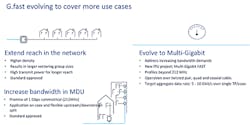Latest from Core/Legacy
Quiz: Are You a Telecom History Scholar?
400 Columns + One Farewell
Providers Like Frontier Embrace G.fast —
It’s human nature to want more in life, so I’m not surprised to see demand for gigabit services grow exponentially amongst residential users. As end-users continue to buy new connected devices and applications, the need for more capacity is being thrust upon operators who must quickly find new ways to quench the bandwidth thirst of its subscribers.
While the number of homes getting connected to Gigabit speeds is growing, many more, for example those in rural areas, are stuck in the broadband slow lane. And with new markets such as Artificial Intelligence and Virtual Reality set to capture consumers’ imaginations and push connectivity requirements to new highs, service providers are facing unforeseen and unpredictable demand — as well as a huge business opportunity.
MDUs: Challenge or Opportunity?
With more than 30 million apartment buildings in the US alone, Multi-Dwelling Units (MDUs) represent a huge slice of service providers’ potential revenue pie. Ranging from single-story buildings with 2 to 4 tenants, to multi-complex/multi-story developments with hundreds of speed and capacity-hungry residents, the potential for increased return on investment is high.
But servicing these buildings does not come without challenges. A large pool of potential customers also means fulfilling high volume demands, with a high number of users, all likely to have multiple devices they wish to connect to.
Then there is each building’s structure to consider — and with no two MDUs likely to be the same, each unit will need its own bespoke solution. In addition to this, they are often served by complex, well-established wiring systems which would be extremely challenging to remold. Add to this, many MDUs feature aging structures that were designed before fiber was even considered.
Given all of these realities, service providers have quite a challenge on their hands — all before they even ask for the owner’s permission to drill holes into their buildings to get the cabling inside.
There is, however, light at the end of the tunnel. MDUs are usually geographically well-placed. They can be within a few hundred meters from a fiber drop that may reside inside the basement or outside façade of a building, in a nearby manhole, or in some cases, in a street cabinet located on a nearby street corner — making them perfect candidates for G.fast.
Getting to a Gigabit With G.fast
First trialed back in 2014 as a new way to deliver speeds of up to 1 Gbit/s over existing copper cables, using the Fiber-to-the-distribution point (FTTdp) architecture, G.fast brought a new lease on life to established copper cables. They put previously unattainable, fiber-like speeds in reach of end users unserved by Fiber-to-the-Home (FTTH) deployments.
Since the initial trials, the rise of G.fast has been rapid, with a growing number of global deployments. Among those first to capitalize on the huge potential presented by G.fast was Engacom, which became the first service provider in Japan to launch its G.fast service in 2016. Other service providers followed suit, and in the case of BT, its efforts to deploy G.fast were particularly ambitious, with a commitment to cover 10 million premises with the technology by 2020.
With its potential confirmed, we are now moving into the next phase of G.fast delivery — and with no need to install new wiring and the same self-installation capabilities as DSL.
Now, G.fast is becoming the ultimate tool to bring Gigabit speeds into MDUs. In fact, the latest Broadbandtrends’ survey Global Service Provider Survey 2018 – G.fast Deployment Strategies & Vendor Leadership stated that the overwhelming objective for deployment of G.fast is the ability to offer advanced broadband services in MDUs with copper infrastructure.
Surveying 33 operators, the survey also found that the top reason for deploying G.fast was the need to be able to provide faster speeds above 250 Mbps to users. Every respondent also stated that Fiber-to-the-Building with a DPU in the basement was a top use case for G.fast. Both these insights point towards the importance of MDUs as key areas of focus for G.fast to have the greatest levels of traction. Also, when we compare this with the broadband trends G.fast survey from 2017, we can see more operators intend to deploy G.fast, going from 22% to 80% of respondents. The top use case is now deployment in MDUs, as clearly identified by 100% of respondents in 2018, vs 85% in 2017. Additionally, in 2018, almost one third of respondents were already in a deployment phase vs 11% in 2017.
Looking Ahead
These statistics reflect what is happening across the globe. Service providers are increasingly turning to G.fast, with the likes of Cincinnati Bell (CBT) and Frontier offering services to customers across the US.
Recent developments in G.fast technology have included rapid growth in the G.fast chipset market. Another game changer in G.fast was unveiled last year, with the first coaxial cables being used to facilitate the technology. The new chipsets enable operators to move from 106 MHz to 212 MHz spectrum and effectively double the speeds delivered from 1 Gbps to 2 Gbps or 1 Gbps symmetrical. Crosstalk cancellation techniques like Nokia’s vectoring technology allow G.fast to be deployed in multi-pair cable bundles, while frequency notching allows G.fast to be deployed with other DSL flavors in the same cable bundle, providing flexible deployment and migration options for operators. For those looking to offer symmetrical services, operators can flexibly pre-provision upstream and downstream bandwidth or use dynamic time allocation (DTA) to split the total bandwidth dynamically as the applications require.
The growth of G.fast is forecast to continue as the technology develops, and the maturing of G.fast standards also plays a significant role here. Coordinated with the FTTdp system architecture project of the Broadband Forum, the ITU published the first G.fast standard in 2014. A certification program run by the Broadband Forum has certified nearly 40 different chipsets, according to its website (https://www.broadband-forum.org), with the aim of ensuring interoperability between different vendors’ products. Today, the next phase of the standard — G.mgfast — is already being worked on, which could conceivably push broadband speeds up to 5-10 Gbps over traditional copper lines.
The Gigabit Future
One example of how G.fast can transform broadband speeds within MDUs can be seen in a project with Frontier Communications. Using G.fast technology, which incorporates built-in vectoring, we dramatically increased broadband speeds within MDUs in Connecticut, US. By leveraging Software Defined Network (SDN) capabilities, G.fast technology was able to successfully facilitate fiber-like speeds, powering new IPTV and data service packages to residents over the existing copper infrastructure. This allowed Frontier to avoid the physical complexities of digging and laying new cables but still achieve the previously unattainable goal of providing
ultra-fast broadband for customers.
For broadband operators who have longed to be able to provide fiber-like speeds without the disruption and high upfront investment, the true value of G.fast is priceless, providing a credible, cost-effective alternative to traditional FTTH options. In a very short space of time G.fast has not only established itself as a way to deliver ultra-fast broadband to previously underserved locations, but it has managed to surpass expectations to become a flexible and highly valuable means to deliver fiber-like-speeds to the masses.
For more information about Broadbandtrends’ survey Global Service Provider Survey 2018 – G.fast Deployment Strategies & Vendor Leadership, please visit https://broadbandtrends.wordpress.com/category/survey/ and https://www.broadbandtrends.com/.






